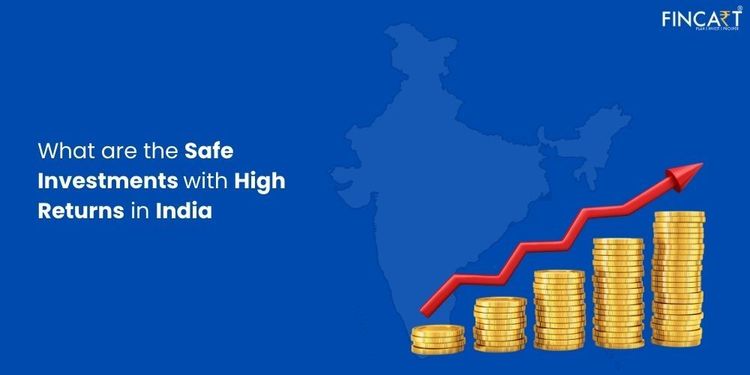Table of Contents
ToggleInvesting your money can be fairly intimidating. Many people worry about the possibility of losing their hard-earned income and it is a valid concern. This fear holds people back from the idea of investing, especially when they’re getting closer to retirement since the people’s risk tolerance tends to diminish with age.
Everyone wants low-risk investments that yield high returns and seeking sound investment advice is crucial in achieving this financial goal. But there’s a trade-off to consider – exceptionally high returns are paired with higher risks. That said, it’s entirely possible to have safe investments with high returns in India. Putting your money to work through investments is way better than letting it collect dust in bank accounts.
Selecting the right investment to put your money in can be very challenging. In this article, we’re going to break down the many different options for safe investments that have the potential to provide high returns!
Safe investment options in India with high returns
Commonly, safe investment options are believed to revolve around two primary categories: equity funds and government-backed funds. Equity funds typically let you buy a small piece of ownership in a wide range of companies. They are relatively stable over the long term. For instance, low-risk mutual funds.
On the other hand, government-backed funds are investments supported by the Indian government, which makes them low risk investments because they guarantee the money’s safety! Now, let’s dive into different investment avenues, and explore their unique benefits.
1. Mutual Funds (MFs)
Mutual funds are a favoured option among retail investors. When you invest in mutual funds, your money is pooled with that of other investors and used to buy a diversified portfolio of stocks, bonds, or other securities. These funds are managed by professional fund managers or investment teams employed by the mutual fund company.
When fund managers create diversified portfolios, it helps spread risk and enhances returns. And on top of that, there are various types of funds to choose from that cater to every individual’s unique risk tolerance!
One of the biggest advantages of mutual funds is the ease of investing, even with a small amount. You can begin your journey with only Rs. 500 and choose to invest regularly through SIPs (Systematic Investment Plans). Now, remember that the returns on mutual funds (MFs) can differ significantly based on the type of fund and market conditions. It is believed that equity MFs offer higher returns in the long run!
Another significant advantage of these funds is their liquidity. Mutual funds are generally considered liquid investments. However; note that the level of liquidity can vary from one fund to another.
2. Fixed Deposits (FDs)
Fixed Deposits are one of the most traditional straightforward and low-risk investment options in our country. There is a probability that you have heard many people talk about investing in FDs.
When you invest in FDs, you deposit a lump sum amount with a bank for a fixed tenure at a predetermined interest rate. They’re a good option because the interest earned is quite higher than what one gets in a savings account. The interest rates on FDs vary from bank to bank and they’re considered safe since they remain stable even in the face of market fluctuations!
However; it’s important to remember that FDs typically have a predetermined lock-in period. Hence, they’re not highly liquid. In case you want to break FD prematurely, the bank levies a penalty, typically a portion of the interest you’ve earned.
3. Public Provident Fund (PPF)
The Public Provident Fund, or PPF, is like a savings account offered by the government that encourages retirement planning and long-term savings. Another great thing that happens when you start investing in a PPF is that you get tax benefits. However; you should know that it requires a 15-year long commitment.
It is a great option for long-term objectives. You can start a PPF account with as little as Rs. 500, and the maximum annual investment limit is Rs. 1,50,000. The interest rate that you get on PPF is reviewed and announced by the government every quarter. In the past, PPF has provided attractive returns, making it a secure and appealing choice for individuals who are ready to stick to a long-term savings strategy!
Also Read: Best Long-Term Investment Plans In India 2024
4. Senior Citizen Savings Scheme (SCSS)
Just like the name suggests, the Senior Citizen Savings Scheme is specific to senior citizens who are aged 60 and above. However, individuals aged 55-60 can also invest in SCSS, provided they meet certain criteria.
It is a government-backed scheme in which seniors can invest a lump sum of money. It allows them to get a regular income plus some tax benefits! When you open an SCSS account, the government sets a fixed interest rate for the money you deposit. You’ll get this interest paid to you every three months, specifically on the first day of April, July, October, and January, directly into your account. Also, you can start with as little as Rs. 1,000, and the maximum amount you can invest is Rs. 30,00,000.
Keep in mind that the maturity period of SCSS is five years, and you have the option to extend it for another three years if you choose to. This scheme offers higher interest rates than regular savings accounts and fixed deposits, making it an ideal option for retirees!
5. Post Office Monthly Income Scheme (POMIS)
The Post Office Monthly Income Scheme is another secure and government-backed way to earn a good income from your invested money. Just as the name suggests, they pay you interest every month! It is validated by the Ministry of Finance.
The upper and lower limit for this investment is Rs. 1,500 to Rs 9,00,000. Even if you have this scheme in different post offices, the total amount you can deposit can’t be more than Rs. 9 Lakhs.
A catch here is that you cannot withdraw your money before 5 years. Also, the interest that is earned does not have any tax benefits. However, the fact that this scheme gives you good returns makes it an incredible choice for traditional investors.
6. Sukanya Samriddhi Yojana (SSY)
Sukanya Samriddhi Yojana was launched by Prime Minister Narendra Modi in 2015 as a part of the “Beti Bachao Beti Padhao” initiative. Its literal translation is, “Girl Child Prosperity Scheme” This scheme is specifically designed to promote the financial well-being of girl children and here is how it works:
A guardian of a girl who is below the age of 10 opens an account for her. Then, they can put money into the account and manage it until the girl child turns 18. After that, the girl has to manage it by herself.
SSY matures within 21 years of opening the account or until the girl gets married after turning 18. However, the guardian only needs to put money into it for 15 years. After that, the account would earn interest even if no money is added to it.
You can start this investment with as little as Rs. 250, and then add more money in multiples of Rs. 50, up to a maximum of Rs. 1,50,000 each year! This scheme not only offers tax benefits but also provides good interest rates. And, importantly, it’s helping to fight a significant problem in our country – gender disparity.
Plus, the money you put into SSY accounts can be deducted from your income when you pay taxes, thanks to Section 80C of the Income Tax Act! This means you get safety, good returns, and tax perks all in one, making SSY a really attractive choice for parents who want to plan for their daughters’ future.
7. National Savings Certificate (NSC)
The National Savings Certificate (NSC) is another government-backed saving scheme. You can open it through any Post Office branch. The idea behind it was to encourage people, especially those with medium to low incomes, to save money and get some tax benefits while they’re at it! However, you should keep in mind that it is a fixed-income scheme that has a maturity period of 5 years. Usually, you cannot leave the scheme before it’s supposed to end. But there are exceptions, like the demise of the investor or any orders by the court.
The minimum limit to purchase an NSC is Rs. 1,000, which can be increased whenever it’s feasible for the investor. It has no maximum limit. When you add up the tax advantage and the guaranteed returns, NSCs become a good choice for investors!
8. Long Term Government Bonds
A government bond is issued by the Government of India. When you buy a bond, you’re lending your money to the government when they require funds for certain projects. The entity then ensures to pay you interest on the initial amount with a specific date on which the full amount would be paid.
These bonds usually have a longer tenure, anywhere from 10 to 40 years, and they come with regular and unchanging interest payments! Government bonds usually give you steady returns. But here’s the thing: the price of these bonds can fluctuate when the interest rates change. That means the value of your bonds may change before maturity!
9. Real Estate Investments
Real Estate Investments are considered very traditional and secure in India! Indeed, they’re not liquid assets, but they offer several other benefits and returns in the long run! The options for real estate investment range from residential to commercial properties.
However, not everyone can afford to make such a huge investment and buy an entire property. That’s where REITs come in. Real Estate Investment Trusts are like mutual funds. You can own a fractional ownership of a commercial property by investing as low as Rs. 500 and can get substantial returns. Also, they’re a highly liquid way to invest in real estate.
The secret to making real estate investments work is location, location, and location! If you carefully select properties in high-demand areas, they can yield substantial returns through capital appreciation and rental income!
Conclusion
There are plenty of safe investments in India, and they all depend on your risk tolerance and goals. If you want a balance between safety and good returns, Mutual Funds can be a smart choice. Fixed Deposits are safe but they come with a lock-in period. If you’re thinking about retirement, the Public Provident Fund and Senior Citizen Savings Scheme are great options. The Post Office Monthly Income Scheme can give you a regular income.
It is always considered smart to talk to an investment planner and diversify your investments to reach your goals. With some thoughtful planning and choices, you can keep your money safe and receive high returns!




